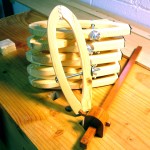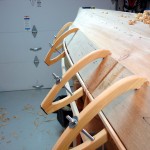My slow and deliberate boatbuilding adventure is slow not only from forgetting to order the right fasteners, but also stopping to make tools as I need them.
 Lapstrake planking is the sort where one plank overLAPS the next. Two tools useful for this kind of construction. First, one needs to mark the width of the lap on a plank edge so that yet another rolling bevel can be planed as a joint area. Some boatbuilder make simple little gauges from a notched piece of wood. That’s basically a one-time use gauge. I decided to make a good marking gauge that will last the rest of my woodworking days. It’s in the foreground of the photo. (Click any picture to see a larger version.) It is made of cherry with a couple of coats of wiping varnish as finish.
Lapstrake planking is the sort where one plank overLAPS the next. Two tools useful for this kind of construction. First, one needs to mark the width of the lap on a plank edge so that yet another rolling bevel can be planed as a joint area. Some boatbuilder make simple little gauges from a notched piece of wood. That’s basically a one-time use gauge. I decided to make a good marking gauge that will last the rest of my woodworking days. It’s in the foreground of the photo. (Click any picture to see a larger version.) It is made of cherry with a couple of coats of wiping varnish as finish.
 Next comes the clamps. Deep throats are needed to reach around the width of the planks, deeper than most c-clamps. These are traditional lapstrake clamps, cut from pine and poplar stock that was already on hand. The hinges are nylon belt webbing and the tip pads are rubber drawer lining material. Finish is 2 coats of boiled linseed oil thinned with mineral spirits. Yes, they are very lightweight, yet are strong enough for this lightweight planking.
Next comes the clamps. Deep throats are needed to reach around the width of the planks, deeper than most c-clamps. These are traditional lapstrake clamps, cut from pine and poplar stock that was already on hand. The hinges are nylon belt webbing and the tip pads are rubber drawer lining material. Finish is 2 coats of boiled linseed oil thinned with mineral spirits. Yes, they are very lightweight, yet are strong enough for this lightweight planking.
The wood that’s clamped to the boat is not a new plank. It is a spiling batten, 1/8 inch thick plywood. Spiling is the measurement process used to discover the shape of the next plank. Measures are taken from the lap line on the garboard plank above and from a thin temporary batten that marks the edge of the next plank.
These are realy cool clamps! What hold the hinge end together?
Thank you for the blog it’s realy good!
I do all my wood working with hand tools and when people ask me how do i rip a wide and thick board in thiner board wile keeping the toe of my saw on the line, I tell them I use a mirror… and also tell theme that I got the idea from a guy who build a boat and rip board that are 10″ wide 16′ long and they don’t think I’m crazy any more but…
Thank you again!
David
David,
The hinge never has any stress. The only purpose of the hinge is to keep the two pieces together for easy handling. My hinges are made from nylon webbing material, the stuff that’s commonly used for straps and handles of handbags and backpacks. These nylon strips are screwed to the clamp sides, one screw on each side of the hinge.
Good to hear you are enjoying resawing. All the best with all your woodworking.
Hi, I like the clamps that you made and the measuring gauge. Do you have any diagrams for them. I am collecting the tools and materials to start a Penobscott 17. and hope to begin after the new year
Happy holidays to all
JH
Hello John,
I did not use any plans for the clamps, just made a cardboard template that I thought was about the right size and then cut a bunch of them. I did have a bookmark for a lapstrake clamp design at “Duckworks Magazine.”
I’m not sure which measurement gauge you refer to. If it is the “reach around” gauge I used for marking the bottom bevel, again no specific plan. The only thing critical on that one is the flat edge is a continuous line. All it does is extend that line around to the other side of a board.
You can find a lot of these sorts of tools in Greg Rosssel’s book “Building Small Boats.”
The Penobscott 17 is a beautiful boat. If I ever build a pulling boat, it is at the top of the list. Good luck with it. I sure would like to see your pictures as you build it.
BTW, de n2ipy.
Thanks for the fast reply,
The gauge is the cherrywood one in the pic.
I love the lines on the P-17 and Mr. Davis is first class.
He is great to deal with on the web as well as the twisted pair.
I rec’d the study plans and there really good too.
I believe we have worked each other on the air. I might even have a QSL from you.
I really haven’t kept my logs up to date lately.
Please QSL via my address.
I have found a few Hams that are boat builders!
anyhow. happy holidays to all.
73 DE KE4IDW
Oh, the “French marking gauge,” aka a panel gauge. I linked to plans in the post about tools, but that link is now dead. An alternative, actually much better, is found in a Popular Woodworking article at http://www.popularwoodworking.com/upload/contents/290/0612_Marking_Gauge.pdf
You’re probably right about an on-air QSO, many years ago, 40m CW QRP. That’s why your name rings a (very quiet) bell. Will QSL.
73 de n2ipy